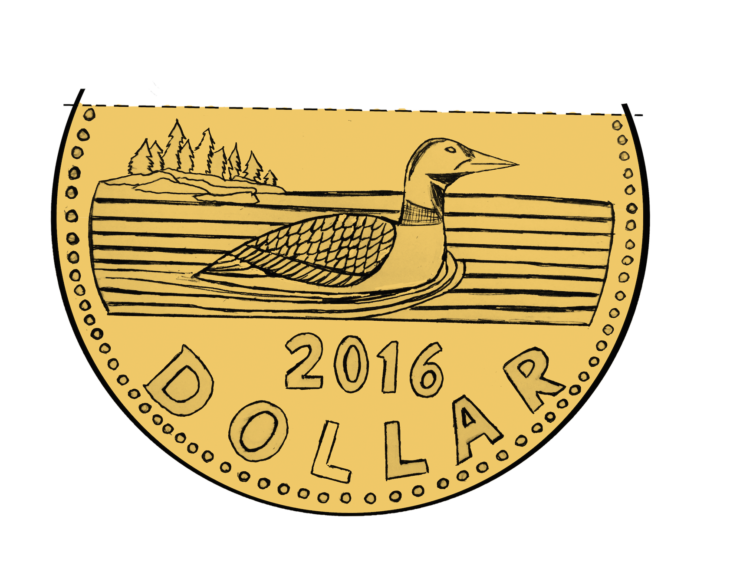Making cents of the low Canadian dollar’s impact on students
When it comes to money, Canadian students have a lot to think about. Tuition costs are rising—for 10 years straight at the University of Ottawa—while student debt continues to be a problem for many after graduation.
So it’s pretty disquieting to hear that, in addition to these considerable issues, the golden coins rattling around in our pockets are now being referred to as “American quarters”.
While our real currency exchange rate is far from that bad—a Canadian dollar is worth about three American quarters—the tumbling dollar’s effects could manifest in various aspects of student life in Canada.
So how did we get here?
Over the past 10 years, the Canadian dollar has shifted in value compared to the American greenback. In mid-2007, it was worth a little bit more than a dollar. In early 2009, after the financial crash, it hit a low point at about 77 cents. At the time of this publication, it has sunk down to 75 cents, still below its lowest point after the 2008 financial crisis.
However, it’s worth noting that this is just the exchange rate with America. The Canadian dollar has actually been tending to appreciate against some other currencies like the Euro over the last couple months.
However, since America is our largest trading partner—according to Statistics Canada they were responsible for 75 per cent of our exports and 66 per cent of our imports in 2015—it’s the American exchange rate that makes the biggest difference in the Canadian economy.
According to Patrick Leblond, an associate professor at the U of O’s Graduate School of Public and International Affairs, there a number of factors that led to the Canadian dollar’s decline. Chief among them are lower prices for our natural resources like oil, and an international reticence to invest in Canada.
“Oil is certainly a huge driver here,” said Leblond. “But natural resources in general are one of the main causes of the low loonie.”
He says that a drop in demand and economic slowdown around the world—especially in emerging markets like China where they have seen their high growth rates fall in recent months—is another primary cause of the dollar’s fall.
“It’s based on supply and demand, and right now the demand coming from Asia that we were used to has slowed down quite significantly,” he said.
Also, interest rates in the U.S. are going up, which means that investors make more money by putting their money into American markets rather than Canadian.
“Investors prefer to hold US dollar denominated investments rather than Canadian ones because they pay higher interest rates,” he said.
He continued that in times of economic uncertainty, which many countries are feeling right now, investors feel safer putting their money into American markets.
Add all this together, and you get the “American quarter”. But what exactly do these financial trends mean for Canadian students?
Textbooks
Leblond says that textbook prices—already the most common topic of complaint when new semesters roll around—could be one of the most noticeable changes in student costs.
Many large manufacturers of Canadian textbooks, like Pearson Education or Oxford University Press, are based outside of the country.
“A lot of the books that we buy come from the U.S., and it’s quite likely that publishers will start increasing their Canadian dollar prices,” said Leblond. “We should see an increase in the Canadian dollar value of (textbooks), which for students is probably the most important element.”
The Financial Consumer Agency of Canada states that the average yearly price of textbooks in Canada is $800-$1000 per full-time student, but says that “costs can vary a lot depending on the program you choose to study.”
If the dollar continues its decline, that back-to-school trip to the campus bookstore might hit your wallet a bit harder than it does already.
Food
 If you think the grocery store is immune to the plummeting loonie, think again.
If you think the grocery store is immune to the plummeting loonie, think again.
A majority of the fruits and vegetables we buy are imported from other countries—think Florida oranges—and as such are tied to the fate of the low Canadian dollar.
Fruits and vegetables are important in maintaining a healthy diet, and the last thing students need is an economic incentive to stop buying them.
But it’s not just fruits and vegetables—The Food Institute of the University of Guelph’s recent Food Price Report predicts a rise in prices in other important categories like seafood, dairy, and grains. The report also projects that meat prices will rise between 2.5 and 4.5 per cent.
In addition, the report also warns of the fact that the average Canadian household will spend $345 more on food this year.
“The wrong kind of food is cheap, and the right kind of food is still expensive,” said Diana Bronson, the executive director of Food Secure Canada, in an article for the CBC.
She also went on to say that that low-and middle-income groups are most affected by the rising price of fruits and vegetables, groups that include senior citizens, the working poor, new immigrants and, of course, students.
Drinks
 The low dollar could also have a sobering effect on beer prices.
The low dollar could also have a sobering effect on beer prices.
Many beers on the Beer Store’s “most popular brands” list come from America, including Budweiser—the most popular beer in Canada by market share—Bud Light, and Coors Light.
The same logic applies for any other alcohol imported from America (or any other country that Canada’s currency is losing value against).
But before you let your spirits sink too low, there’s better news about wine prices.
According to a TD Economics report from last year, since many of the wines purchased in Canada come from European and South American countries, and since the dollar hasn’t had the same depreciation against those currencies, the price of wine should be safer from the low dollar. There’s never been a better time to get adventurous with your liquor cabinet.
Transportation
 But wait! Gas is so cheap now, that must be better for students, right? Well, it’s not quite that simple.
But wait! Gas is so cheap now, that must be better for students, right? Well, it’s not quite that simple.
While prices at gas stations have been decreasing since last summer, they’re actually a bit higher than they were at this point last year, according to Natural Resources Canada.
Of course, this also means that Canada is seeing lower profits on its oil, one of its largest exports, which is bad for Canada’s economy as a whole.
Of course, there’s an argument to be made that Canada shouldn’t be relying so heavily on our oil exports in the first place, and that the structure of our economy is due for a change anyway.
International
 Last year, the Fulcrum compared the number of international students coming to study in Canada, as opposed to Canadians going abroad, and found that the number of incoming students vastly outnumbered outgoing ones. With the low Canadian dollar, that effect will likely only multiply, as it costs less to come here, and costs way more to leave.
Last year, the Fulcrum compared the number of international students coming to study in Canada, as opposed to Canadians going abroad, and found that the number of incoming students vastly outnumbered outgoing ones. With the low Canadian dollar, that effect will likely only multiply, as it costs less to come here, and costs way more to leave.
The effects could be compounded for French international students, as they are charged domestic tuition rates at the U of O.
Leblond says that now may not be the best time for students to go abroad for any reason, scholarly or otherwise.
“If they were planning to go to places like Florida… then it would make their vacation a lot more expensive.”
What comes next?
Since bottoming out at 68 cents on Jan. 16, the loonie has been slowly trekking back up as of late. Unfortunately, even with this trend, there is no certainty that value will continue to rise in the future.
Even the Bank of Canada can do little to change the dollar’s course, says Leblond.
To keep the value of their currency high, some governments use their own stash of foreign currencies to buy their own currency, raising the demand and therefore the price. But Leblond says that isn’t an option, as even the Bank of Canada can do little to change the dollar’s course.
“That would be pretty much a losing battle, because the Bank of Canada doesn’t have enough resources in terms of foreign currency.”
He added that the Bank of Canada has a policy of not intervening in currency markets anyway.
Leblond says that there are a couple bright spots. The lower Canadian dollar will be good for non-oil Canadian exports like wood and paper, since they will be cheaper on the world market and haven’t experienced a dramatic decline in demand.
“Things can change in a matter of a few years,” he said, eluding to tools that the federal government is considering like increasing spending on infrastructure projects. “It’s better to just leave the dollar where it is and focus on how we can make the Canadian economy more competitive.”
Unfortunately for students, there’s no certain way to predict when things will change for the better.
In the meantime, lay off the imported beer and get used to learning straight off the Internet. It may save you next month’s rent.




